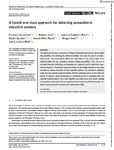Mostrar o rexistro simple do ítem
A hybrid one-class approach for detecting anomalies in industrial systems
| dc.contributor.author | Zayas-Gato, Francisco | |
| dc.contributor.author | Jove, Esteban | |
| dc.contributor.author | Casteleiro-Roca, José-Luis | |
| dc.contributor.author | Quintián, Héctor | |
| dc.contributor.author | Piñon-Pazos, A. | |
| dc.contributor.author | Dragan, Simić | |
| dc.contributor.author | Calvo-Rolle, José Luis | |
| dc.date.accessioned | 2023-01-12T13:30:31Z | |
| dc.date.available | 2023-01-12T13:30:31Z | |
| dc.date.issued | 2022-03-08 | |
| dc.identifier.citation | Zayas-Gato, F., Jove, E., Casteleiro-Roca, J.-L., Quintián, H., Piñ on-Pazos, A., Simi c, D., & Calvo-Rolle, J. L. (2022). A hybrid one-class approach for detecting anomalies in industrial systems. Expert Systems, 39(9), e12990. https://doi.org/10.1111/exsy.12990 | es_ES |
| dc.identifier.issn | 1468-0394 | |
| dc.identifier.uri | http://hdl.handle.net/2183/32333 | |
| dc.description | Financiado para publicación en aberto: Universidade da Coruña/CISUG | es_ES |
| dc.description.abstract | [Abstract]: The significant advance of Internet of Things in industrial environments has provided the possibility of monitoring the different variables that come into play in an industrial process. This circumstance allows the supervision of the current state of an industrial plant and the consequent decision making possibilities. Then, the use of anomaly detection techniques are presented as a powerful tool to determine unexpected situations. The present research is based on the implementation of one-class classifiers to detect anomalies in two industrial systems. The proposal is validated using two real datasets registered during different operating points of two industrial plants. To ensure a better performance, a clustering process is developed prior the classifier implementation. Then, local classifiers are trained over each cluster, leading to successful results when they are tested with both real and artificial anomalies. Validation results present in all cases, AUC values above 90%. | es_ES |
| dc.description.sponsorship | Xunta de Galicia. Consellería de Educación, Universidade e Formación Profesional; ED431G 2019/01 | es_ES |
| dc.language.iso | eng | es_ES |
| dc.publisher | John Wiley & Sons Ltd | es_ES |
| dc.relation.uri | https://doi.org/10.1111/exsy.12990 | es_ES |
| dc.rights | Attribution 4.0 International (CC BY 4.0) | es_ES |
| dc.rights.uri | http://creativecommons.org/licenses/by/3.0/es/ | * |
| dc.subject | Anomaly detection | es_ES |
| dc.subject | Clustering | es_ES |
| dc.subject | Industrial system | es_ES |
| dc.subject | One-class | es_ES |
| dc.subject | Optimization | es_ES |
| dc.title | A hybrid one-class approach for detecting anomalies in industrial systems | es_ES |
| dc.type | journal article | es_ES |
| dc.rights.accessRights | open access | es_ES |
| UDC.journalTitle | Expert Systems | es_ES |
| UDC.volume | 39 | es_ES |
| UDC.issue | 9 | es_ES |
| dc.identifier.doi | https://doi.org/10.1111/exsy.12990 | |
| UDC.coleccion | Investigación | es_ES |
| UDC.departamento | Enxeñaría Industrial | es_ES |
| UDC.grupoInv | Ciencia e Técnica Cibernética (CTC) | es_ES |
Ficheiros no ítem
Este ítem aparece na(s) seguinte(s) colección(s)
-
Investigación (EPEF) [590]






